Catalano Square
Examining the Historic Third Ward's most prominent park.
There are plenty of reasons the Historic Third Ward has garnered a reputation as an urban revival success story. With its sidewalk cafés, stunning historic structures teaming with offices and toni apartments, and quality infill that continues to stretch out its Eastern fringe, the neighborhood is well-deserving of its gilded name. Less quick on the lips of Milwaukeeans and visitors alike, however, is the neighborhoodʼs premiere public space – Catalano Square. Which is not to say that the space goes unused. Indeed, described by the Third Ward Association as that neighborhoodʼs “outdoor gathering place,” Catalano plays host to a number of events, such as the Summer Sizzle Jazz Festival and Christmas in the Ward, among others. Catch the space on the right day or at the right hour and the square exudes an urbanity and vibrancy befitting this great city.
Built amid initial efforts to revive the struggling district, the square is the product of a $3.4M streetscapes project completed in 1992. Prior to construction, the segment of Broadway running through the Historic Third Ward was a one-way street connecting directly to the Broadway bridge. The triangular park that emerged from those efforts, bounded by E. Menomonee St., E. Erie St., and N. Young St., was a key component in efforts to bring a more pedestrian and green feel to the neighborhood. The name chosen for the space comes from Mariano Catalano, an Italian immigrant who arrived in the city in 1884 and who by 1910, together with his brothers, had become one of the largest wholesale distributors on Broadway.
Highly programmed on the northwestern edge formed by E. Menomonee St. and that terminates Broadway, the space includes quality brick pavers, plenty of primary and secondary seating (think low-slung walls), and a number of artistic and historic amenities, including the recent addition of a refurbished trolley-shelter-turned-busshelter donated by the Friends of Hank Aaron State Trail, as well as the futuristic “Stratisformis” sculpture by artist Jin Soo Kim. But this is not only a space for looking, but also one for contemplating. In the spaceʼs more defined western edge, one finds ample seating in what the Historic Third Ward describes as an “urban amphitheater” as well a series of large flower beds, all centered around the signature Dragotta Fountain. According to representatives of the Historic Third Ward, the fountain takes its name from Frank Dragotta, who operated Draggʼs Café on the square from the 1950s to 1994 and “is dedicated to the Italian families who helped develop the neighborhood.”
Beyond its history and lineup of events, much of the success of the square derives from the relationship it maintains with the surrounding area. Acting as the southern terminus of the districtʼs signature boulevard, the square nicely compliments the Historic Third Wardʼs northern gateway space – the Milwaukee Public Market – found merely three bustling and eminently stroll-able blocks to the north. This concept of anchor spaces meant to pull people along a central corridor should be familiar to anyone whoʼs ever set foot in a mall. Just so, these two magnets work to exert a complimentary pull on visitors. But unlike the local mall, those emerging from the Public Market or a nearby restaurant on a sunny afternoon are presented with more options than the sterility and placelessness of the mall parking lot. To them go the options of a city, a city replete with life and idiosyncratic variety and made complete by a square fully open to the flow of it all, in all its imperfections and delights. And thatʼs perhaps the highest praise that could be lavished on this diminutive public square – that it is a space in and of the urban fabric. A true urban Milwaukee experience.
(special thanks to the Historic Third Ward Association for the valuable information they provided for this article)
This is the first article from new contributor Michael Kavalar.

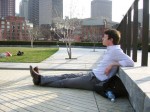
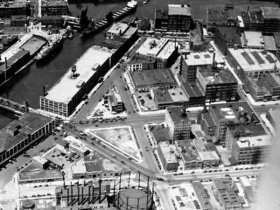
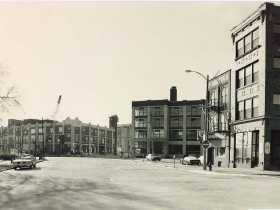
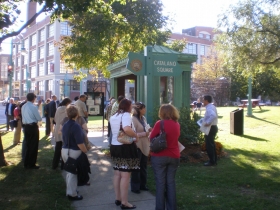
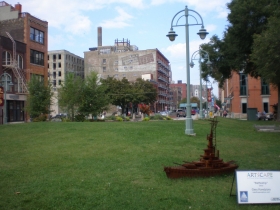
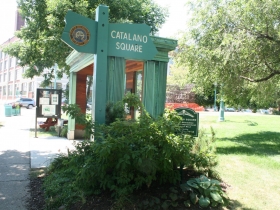
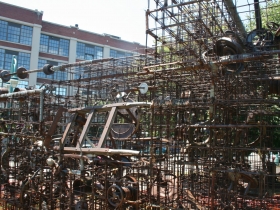


















Catalano Square is one of the City’s better public spaces, for all the reasons listed above. I wish we had 20 more of these great urban pocket parks knitted into the city’s fabric.
It’s especially thought provoking to see the historic “before” view… Makes you consider all the other streets that may be ripe for this kind of thinking. It’s also compelling evidence for the naysayers that will certainly want to decry efforts that turn streets from simple car-conveyors to people places.
Too bad there isn’t a cafe still fronting hard-scaped square. It would be wonderful to see tables and chairs routinely lining the space.
Excellent article.